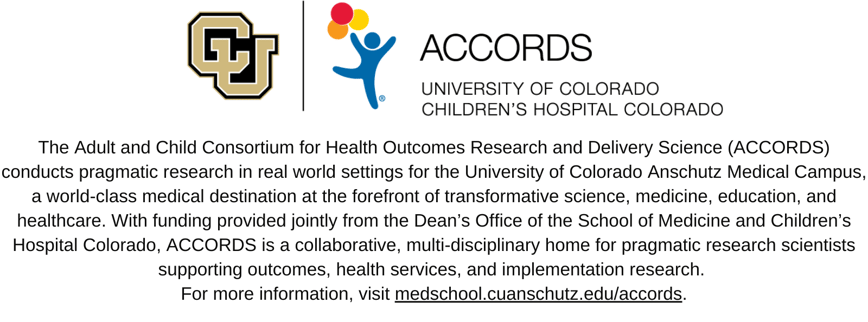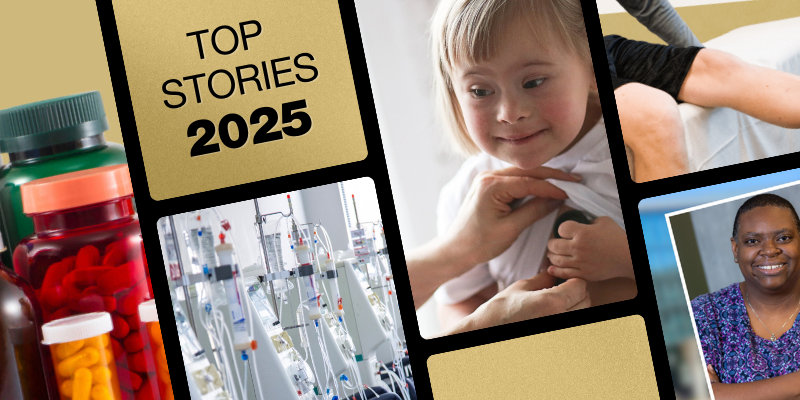There is a strong thread that ties every core or program within ACCORDS together. While each team addresses research in one facet or another, their disciplines span a wide range of academic specialties, some with almost no visible relation to one another. But the primary goal that unifies each member of ACCORDS, and truly, the entire CU Anschutz community, is the desire to improve people’s lives through scientific research and practice.
The Dissemination and Implementation (D&I) Science Program at ACCORDS uses stakeholder engagement and pragmatic D&I models, methods, and measures to build D&I capacity within scientists, systems, and communities, and to develop, test, and disseminate sustainable and equitable solutions to real-world problems.
Implementation science is trying to get
evidence-based programs that improve
health out into the real world where they
can actually do just that—
improve people’s health.
“Implementation science is trying to get evidence-based programs that improve health out into the real world where they can actually do just that—improve people’s health,” says Amy Huebschmann, MD, associate professor and implementation scientist for the ACCORDS D&I Science Program.
The program’s team of seasoned experts are available to partner with CU researchers and to serve as the implementation scientists on studies (now required by many RFPs and grants). The D&I Science Program also provides navigation assistance for campus researchers unsure if their project is “ready for D&I” and helps researchers connect with other relevant resources or disciplines. The program offers a variety of online resources, guides, and interactive tools that can stand alone or serve as part of person-to-person consultation.
The program describes itself as a fairly cosmopolitan group that draws on local faculty as well as those from around the country. “We have a nationally-renowned group of D&I scientists who have come together to build capacity in conducting implementation science research,” says Huebschmann. “The ACCORDS D&I Science Program is seeking to be cutting edge in its discussion with our academic community who are trying to find ways to improve their research methods and programs.”
A new framework
A major emphasis for the D&I Science Program that permeates its resources, trainings, and advising is the RE-AIM framework, developed by Dr. Russell Glasgow, the head of the ACCORDS’ D&I Science Program. According to Clarivate Analytics, Glasgow is in the top 1% of the most cited social scientists in the world.
This is all necessary for successful
research that truly makes an impact.
Trained as a clinical psychologist specializing in health behavior change, Glasgow spent years working on a research team with a successful smoking cessation program that struggled to recruit the most at-risk users. “We wanted to understand how to reach more people from a wider range of backgrounds, in a variety of settings (worksites, schools, hospitals, dental offices), and truly reach the community as a whole,” says Glasgow. “In attempting to increase our reach, I realized the limitations of my training in this capacity. I started to understand the necessity of considering the broader context we perform research in and how it fits together with other components of a given study. This is all necessary for successful research that truly makes an impact.”
In 1999, along with two other researchers, Glasgow developed and published an article on the RE-AIM framework (Reach, Effectiveness, Adoption, Implementation, Maintenance) to address issues common in dissemination research (such as context).
“The goal of RE-AIM is to help researchers broaden their focus and realize that they need to not only to have an effective program but one that has good reach and can be broadly adopted and implemented in the real world,” says Glasgow.
The goal of RE-AIM is to help
researchers broaden their focus
and realize that they need to not
only to have an effective program
but one that has good reach and
can be broadly adopted and
implemented in the real world
The initial RE-AIM article was published almost three decades ago, and Glasgow and his team have recently published a new article that summarizes the usages, mis-usages, and resources to support the framework. In more recent years, Glasgow and other RE-AIM researchers are focusing increasingly on the importance of context.
Addressing context
“Around 2008, we expanded the RE-AIM model to include PRISM (Pragmatic Robust Implementation and Sustainability Model),” says Glasgow. “This addition focuses on different contextual factors and how they influence different RE-AIM outcomes. We believe that PRISM considerations need to be addressed if researchers are going to produce and sustain strong outcomes. For example, the setting, characteristics, perceptions, relationships among multiple stakeholders, as well as their history and resources, often determine what interventions and strategies will and will not work.”
Glasgow remains confident that the PRISM/RE-AIM model is more intuitive and practical than many other alternatives in the field. “D&I scientists have many, possibly too many, theories, models, and frameworks to help guide research,” he says, “but I do think ours is more easily understood, practical, and easier to apply than most alternatives.”
Much of Glasgow’s time is now spent mentoring other researchers and demonstrating how PRISM/RE-AIM can be used to address health equity issues across different research disciplines and settings. “Researchers from a public health perspective are exploring the fundamental causes of health and illness, which address more structural issues including poverty, discrimination, and policies,” he says. “In primary care, where I'm doing much of my work, we consider social needs issues like food availability, safety, transportation, housing, etc. We are actively trying to think about how PRISM/RE-AIM can help address these issues.”
For researchers curious as to how they can improve their programs and studies with the use of the PRISM/RE-AIM framework, Glasgow recommends becoming familiar with both the RE-AIM literature and the group’s interactive resources which include example applications, worksheets, tools, E-books, and more.
Certificate Training in D&I
A new program that is of importance both locally and nationally is the ACCORDS D&I Science Graduate Certificate Program, offered by ACCORDS and Colorado Clinical and Translational Sciences Institute at the CU Anschutz School of Medicine and under the direction of Huebschmann. This 12-credit online program (a combination of didactic and applied training) is in its second year and helps students understand D&I frameworks to improve evidence-based research projects.
Students in the certificate program create a comprehensive research proposal as they advance, allowing them to immediately apply their learning. They also develop pieces of grants throughout the program to sharpen their grant writing and applications. “I'm really excited that we're able to offer this certificate program to both our researchers at the University of Colorado, around the country, and internationally,” says Huebschmann. “Our students are doing a wide range of research, yet they're all applying similar methods of how to translate and implement.”
“It's such a robust learning community and the students are so enthusiastic and collaborative,” she adds. “I think the faculty set the tone for that. I'm really thrilled that we have such an amazing group of knowledgeable faculty who are excited to see their students learn and provide them with detailed feedback and attention, which is not always a guarantee in other programs.”
More information on the graduate certificate program can be found HERE. The next application cycle will begin February 2022.




